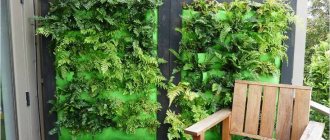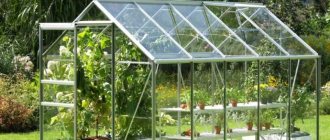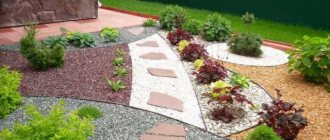What varieties of peaches are suitable for the Moscow region?
I will continue the story about peaches growing in the Moscow region.
Previously, these plants were considered exotic. Now there are many zoned varieties for our strip. They are sold in almost every nursery or gardening store.
Most gardeners buy a seedling only because they liked a beautiful picture or were recommended by one of their friends. They wait a long time for the tree to grow, begin to bear fruit abundantly and bear large, juicy peaches.
Most often, such people will be disappointed: some do not like the taste, some fruits do not ripen, or even simply do not bear fruit. Why? The answer is simple - this variety is not suitable for the conditions and terrain. I do not recommend buying plants in the store. Sellers there can rarely give high-quality recommendations and help you choose the right variety specifically for your conditions.
| Variety Redhaven |
Representatives of private nurseries can tell you all the necessary information, and they have a much larger choice. The most important thing is that all seedlings grow in local conditions. They are not brought from far away. The plant easily adapts to the characteristics of your territory. Of course within reasonable limits. (You can’t plant it in sand or in a hole where there is a lot of groundwater). Temperatures in different areas of the Moscow region may vary slightly.
The best option is to purchase varieties that are already growing and bearing fruit from your neighbors.
Early maturation
Redhaven.
This imported variety is perfectly zoned. It tolerates Russian winters and spring frosts well. Resistant to curl and other diseases, but susceptible to fungal infections. Most often they arise due to improper agricultural practices. Peach can be protected from diseases by timely application of fertilizers and proper stimulation of growth and development. Preventative treatment is also necessary. It is advisable to carry it out in early spring or late autumn, but before the onset of rain.
Redhaven is a very large and juicy variety with excellent taste. The color of the fruit is yellow-orange interspersed with red stripes or spots. The pulp is tender with a strong and pleasant aroma.
The variety has shown excellent results in both private and industrial gardening.
Collins.
For lovers of very large fruits, we can recommend the Collins variety. The peach is sweet, but with a slight sourness.
It is very productive. Therefore, the fruits must be removed immediately after they ripen. The branches of the plant need supports during ripening, otherwise they may not support the weight of the fruit and break off.
It tolerates winter cold and spring cold well. Resistant to powdery mildew and curl.
Its main difference is that it requires large amounts of fertilizing, abundant watering and timely formation of the crown and regular pruning of branches.
Middle and late ripening
Cardinal.
Cardinal is very resistant to powdery mildew. Basic care consists of regular feeding and abundant watering.
The fruits are medium in size, but very tasty. On the tasting scale, it is rated 5. This is the highest rating of its taste.
Kremlevsky.
The variety shows excellent winter hardiness and disease resistance, which is very good for cool climates, including the Moscow region.
The fruits of the Kremlin variety have a sweet or sweet and sour taste. They are very fragrant and juicy. They are orange or yellow with a red blush.
Harbinger, Harrow Diamond, Harnas, Early Redhaven, Harko, Suncrest, Inka
– these are new winter-hardy and frost-resistant varieties of peaches, adapted to our climatic conditions. Among them are nectarines and fig peaches. They also showed good fruiting in the conditions of the Moscow region.
Cherries
When deciding which fruit trees to plant on your site, you should consider cherries. This wonderful, romantic and beautiful tree will decorate any garden. Previously, it was believed that it does not ripen well in the middle zone, but now special varieties suitable for the Moscow region have already been bred. Their fruits are tastier than those from the south, ideally combining sourness and sweetness. It is advisable to plant several cherries on the site, choosing different varieties. The harvest is usually taken in June and July, the timing depends on the ripening group: there are early, middle and late varieties. The early ones include “Krasnaya Gorka”, “Iput”, “Chermashnaya”, the middle ones - “Teremoshka”, “Fatezh”, “Rechitsa”, the later ones - “Revna”, “Tyutchevka”, “Bryanskaya Rozovaya”.
Optimal timing for planting cherries
It is best to plant cherries in the Moscow region in mid-April during spring planting, or during October, a month before the onset of autumn cold weather. When the threat of spring frosts has passed, the seedlings are ready for planting. The development of cherry seedlings strongly depends on the heating of the soil and the surrounding air: a temperature of plus ten degrees is the borderline temperature, at which the growing season begins and ends. The plant goes into a dormant state when the temperature drops below plus ten degrees. Therefore, it is best to plant seedlings when the soil warms up above +15ºС.
Evergreen deciduous plants
Coniferous or evergreen deciduous trees are also used in the design of homestead areas. Today there are many varieties of trees and shrubs that are capable of decorating a site with their fresh and bright crown throughout the year.
Rhododendron
More than 600 species of rhododendron grow in the world, some of which are deciduous, and some are evergreen. One of the most popular genera is azalea.
Azaleas are heat-loving, require careful care, they need acidic soil and regular fertilizers.
Boxwood
A slow-growing, unpretentious plant that in Russia grows mainly on the Black Sea coast.
One of the most ancient shrubs used for landscaping. Since boxwood easily tolerates pruning, it is well suited for creating hedges and sculptural compositions.
Euonymus
A small tree with an openwork crown and small leaves that turn into bright and unusual colors in autumn
There are also large varieties, the crown width of which can reach 10 m. Dwarf and creeping varieties are often used in decorating areas, effectively entwining fences and hedges.
How to choose shrubs for a dacha in the Moscow region?
Even the most frost-resistant crops often cannot withstand the climate of the Moscow region. The thing is that frost resistance does not mean winter hardiness. The first means that the plant is able to withstand some maximum negative temperature (for example, -40 degrees). The second definition indicates the resistance of the species to various weather disasters (sharp changes in heat and frost, unexpected frosts in the fall or after a thaw).
So, what fruit trees can you choose for the Moscow region:
- Apple tree. Propagated by grafting onto seedling, semi-dwarf and dwarf rootstocks. It is advisable to have varieties in the garden with different ripening periods and winter hardiness. The optimal ratio (subject to the presence of a basement for storage) is: 20% summer varieties, 30% autumn varieties and 50% winter varieties. If there is nowhere to store the crop, then you need to plant fewer winter varieties.
- Pear. It grows well in the conditions of the Moscow region, provided that the variety is chosen correctly. You can have summer and autumn-winter options.
- Common cherry. The most dangerous thing for cherries is spring frosts. If varieties are self-sterile, others will be needed for pollination.
- Cherries. While this crop is not often found in northern gardens, there are still suitable varieties. Local cherries are not inferior in taste to southern varieties.
- Dukes. It is a hybrid of cherry and cherry. Can withstand frosts below -25o C. Self-sterile.
- Plum. The least demanding crop in terms of weather conditions. Propagated by grafting onto cherry plum or plum seedlings.
- Cherry plum. In many respects it is superior to domestic plum; there are varieties with high taste qualities. Cherry plum is a self-fertile crop; pollinators are required.
- Apricot. It tolerates frosts near Moscow quite well; spring frosts pose some threat to flower buds. Several varieties are required for effective fruiting.
- Sea buckthorn. It is a dioecious plant, so at least one male specimen on the windy side is needed on the site. Propagated by layering, cuttings, and less commonly by grafting.
- Honeysuckle. A very early and frost-resistant shrub crop, which is becoming increasingly in demand among gardeners in the northern regions. Requires multiple varieties for cross-pollination.
- Black currant. Everyone's favorite berry crop. A couple of bushes in the garden with different ripening periods are enough.
In order for the shrub to fit organically into the existing landscape, plants for summer cottages in the Moscow region must be selected according to the following criteria:
Decorative culture
The most important feature when choosing a plant is its attractiveness. The gardening market today presents a wide selection of ornamental plants with unusual foliage colors, shapes, and elegant flowers of various shades that exude pleasant aromas.
For flowering shrubs, an important criterion is the period of its flowering, so when choosing, you need to choose varieties that will alternate in their flowering along with the changing seasons of the year; Plant height. When planting shrubs, you need to ensure that the compositional structure of the entire area is observed. If its area is small, then compact varieties of plants with a non-spreading, dense crown (for example, columnar junipers) are perfect for it. When shrubs are planted to create a hedge, you should buy fast-growing varieties, taking into account the shape of the crown and attractive appearance at any time of the year; Features of cultivation. When choosing plant varieties, it is necessary to take into account the climatic characteristics of the place where planting is planned. Some shrubs are more suitable for semi-shaded places, while others only show decorative value in illuminated areas.
Exotic species of decorative deciduous trees
Snow tree (aka snow flower)
Among the new exotics is the Virginian snowflower, or snow tree, which grows beautifully in central Russia and blooms regularly, provided it is carefully covered for the winter. In the warm season, it needs maximum lighting for lush flowering. Photo of snowflower:
Canadian scarlet
Canadian scarlet - Cercis - is an amazingly beautiful plant that recently appeared in the Moscow region. He, like other exotic representatives, needs good shelter for the winter, for which he will thank the foliage of amazing shape and color in the warm season. Photo:
Japanese sakura (winter cherry)
For the Moscow region, the best option is to plant winter-hardy ferruginous cherries, which are a fairly close relative of sakura and are perfectly adapted to the harsh conditions of the Russian winter. The ferruginous cherry, which can amaze with its splendor and abundance of flowering, is an ornamental plant that does not produce fruit.
Northern catalpa is another exotic novelty:
THERE ARE DISPUTES ABOUT TASTES
Root vegetables of original colors have begun to gain popularity in the Moscow region in the last five years. The fashion came from Europe, where white carrots and yellow beets became quite common. For example, the official dealer of the well-known seed company Bejo, operating in the Leninsky district, carries planting material from Holland. The organization presented its products at the agricultural forum “Modern Vegetable and Potato Industry. Moving Up”, which took place in the Dmitrov urban district last week. In the Moscow region, such crops have a great future, experts say.
“Moscow region producers are in a more advantageous position compared to farmers in other regions of the country,” emphasizes the company’s leading manager for key clients, Alexander Piskarev. – As a rule, all new products reach here faster, which means that manufacturers can appreciate their advantages earlier.
Regional farmers have already begun to grow unusual crops, such as purple, bright yellow and white carrots of the Purple Hayes F1, Mello Yellow F1 and White Satin F1 varieties. In supermarkets, such products in their natural form can still rarely be found: manufacturers are afraid that consumers “will not understand.” Therefore, most often these vegetables are sold in the form of salad mixes.
“Not only the color, but also the taste is different,” says Alexander Piskarev. – For example, white beets are very sweet. And yellow carrots, due to their nutritional qualities, are perfect for pilaf.
Seedling care
Fertilizing the apple tree
Further care for the apple tree consists of regular loosening, weed removal, fertilizing and watering. If it's a rainy spring, watering can be reduced. While loosening the tree trunk, nitrogen fertilizer is added to help roots and branches grow faster.
Watering in the first month is carried out every week, 2 buckets of water for each apple tree. In the future, 4-5 buckets every 3 weeks will be enough.
Important! In winter, the trunks of young apple trees must be insulated by wrapping them with covering material for the first 3-4 years. This measure will also protect the tree from rodents
Shrubs of the Moscow region: names
This group includes not only domesticated cultivated plants. Wild shrubs of the Moscow region also widely inhabit local biotopes. The most common among the cultural forms that fill summer cottages and gardens are fruit and berry species.
- Grapes of various varieties.
- Quince and various varieties of plums.
- Blueberry.
- Honeysuckle.
- Gooseberry.
- Raspberries.
- Rowan.
- Currant.
- Yoshta.
- Blackberry.
Among the wild-growing organisms of this group, we can distinguish such as euonymus, wolfberry, dogwood, bladderwort, maple, lilac, Middendorf weigela, elderberry, broom, dogwood, rhododendron, forsythia, oleaster, peony, rowan, roses, almonds, hawthorn, willow, barberry and others.
Winter varieties
Late varieties are distinguished by even greater qualities in terms of shelf life, as well as many taste characteristics. Among them are the following: Pass-Crassan, Saratovka, Kondratievka, Olivier de Serre, Otechestvennaya, Josephine of Mehelnaya, Bere Ardanpont and others.
When choosing varieties for the Urals, Siberia, for the Moscow region or even for Ukraine, we would advise you to start not only from cute names and ripening periods, but also be sure to pay attention to the characteristics of the plants. It is worth noting the fact that many types of pears and apples can grow with virtually no care, that is, it will be enough to plant trees in the garden or even outside the yard, sometimes water them, harvest and trim only those branches that are in your way
But it is quite possible that you will choose columnar varieties of pears, Chizhovskaya, Bera, Lada, Severyanka, Lesnaya Krasavitsa, Maria or others with large and sweet fruits. In this case, the trees will definitely need stable care if you, of course, want to have a constant harvest
It is worth noting the fact that many types of pears and apples can grow with virtually no care, that is, it will be enough to plant trees in the garden or even outside the yard, sometimes water them, harvest and trim only those branches that are in your way. But it is quite possible that you will choose columnar varieties of pears, Chizhovskaya, Bera, Lada, Severyanka, Lesnaya Krasavitsa, Maria or others with large and sweet fruits. In this case, the trees will definitely need stable care if you, of course, want to have a constant harvest.
Rose hip
Since ancient times, this plant has been considered a healing source of important substances and vitamins. Avicenna also called rose hips a remedy for liver diseases. Today this plant is valued not only for its medicinal properties, but also for its beautiful appearance and unpretentiousness to living conditions. Delicate crimson roses leave no one indifferent. Flowering continues from mid-May to the end of June.
All parts of the plant except leaves are used to make medicines: fruits, roots, stems and flowers. The most valuable substances in the plant are carotenoids, vitamins B and PP, flavonoids, organic acids, and essential oils.
When is it better to plant - in spring or autumn?
When is it better to plant fruit trees in the Moscow region - in spring or autumn? There is no consensus on this matter. Everything depends on climatic factors
Pay attention to the amount of precipitation, air and soil temperatures, temperature changes
It is important to remember that the earth must be warmed up; There is no point in planting fruit trees in frozen soil. The seedlings will not take root or will often get sick
The seedlings will not take root or will often get sick.
Advantages and disadvantages of spring planting
In spring, plants are planted immediately after the snow melts. Delay in this matter is unacceptable: if you miss the due date, the amount of growth decreases and fruiting is delayed. This is the main disadvantage of spring planting.
In the spring, heat-loving trees are planted - peach, apricot, cherry. They need time to adapt to climatic conditions. If you plant them in the fall, there is a high risk of winter frost. It is also convenient that the planting hole is prepared for spring before winter; After the snow melts, all that remains is to prepare the seedlings and send them into the ground.
Also in the spring, summer residents have the opportunity to quickly respond to changes occurring with seedlings. For example, monitor their development and carry out preventive measures to protect against diseases and pests. And the spring supply of water in the soil has a positive effect on growth.
Pros and cons of autumn planting
In autumn, plum, apple, pear and quince trees are planted. Plants have time to take root before the onset of frost, and under the snow cover they gain strength for further development. One of the advantages is that in the fall there is a wider choice of different varieties of fruit trees. Vienna does not have such diversity.
However, autumn planting is not suitable for heat-loving plants. At this time, summer residents use seedlings with closed roots or container planting material. The roots must be in perfect condition, otherwise poor survival rate is guaranteed.
Which vegetables and greens are healthier?
Experts advise eating more fresh greens. It can be added to absolutely any snacks, soups, hot dishes, it helps digest heavy protein foods.
Dill and parsley contain essential oils, carotene, iron, potassium and phosphorus, and natural antioxidants - flavonoids.
Fresh basil, rosemary, and thyme are very useful. Basil, both green and burgundy, contains a lot of essential oils, vitamin K, manganese and zinc. All three plants have an antimicrobial effect and help normalize microflora.
To have them on your table all year round, buy these fragrant plants in pots, transplant them into a larger container and grow them on a balcony or windowsill.
It is better to choose leaf or iceberg - these varieties grow well in the Moscow region, unlike greenhouse arugula. The salad contains a lot of vitamin C, which the body needs to switch to the summer season and maintain health after prolonged cold weather. In addition, it contains folic acid, PP vitamins, and carotene.
In the middle zone, lettuce is harvested throughout the summer, with slight variations depending on the variety.
Any cabbage, including Brussels sprouts, cauliflower and regular cabbage, is rich in antioxidants.
According to Elena Ostrovskaya, nutritionist, endocrinologist at Dr. Kovalkov’s Clinic, these substances bind free forms of oxygen formed in the body due to stress, increased stress, and poor nutrition, and neutralize their negative effect.
Early varieties of young cabbage appear in the Moscow region as early as June.
Tomatoes contain the antioxidant lycopene, they help strengthen blood vessels, improve oxygen access to tissues and have antitumor properties.
Experts believe that tomatoes are very healthy even when dried, fried, baked, or in the form of tomato paste. Fermentation only intensifies, but the benefits remain.
Tomatoes are widespread and grow in Russia both in the south and in mid-latitudes. In the Moscow region, tomatoes begin to ripen only in July.
Special substances - anthocyanins contained in spinach - can slow down negative changes in cells
This is especially important for tumor processes and for older people. Spinach has a high content of beta-carotene, selenium, magnesium, potassium, phosphorus, iron and vitamin K, which is responsible for hematopoiesis and elasticity of the walls of blood vessels.
All these beneficial substances act synergistically and have a positive effect on human health.
Experts warn that adult spinach contains large amounts of oxalic acid, which can disrupt the acid-base balance and contribute to the formation of kidney stones. Therefore, it is better to eat the youngest spinach, fresh shoots. Nutritionists recommend adding a teaspoon of 10 percent cream or a little butter to spinach - this will neutralize the acid.
You can eat spinach in winter: frozen, but not chopped. It is believed that the best harvests in the warm season occur in April and mid-August.
Nutritionists are unanimous in their opinion: this vegetable is very healthy; its bright color increases the level of serotonin, a substance responsible for the feeling of joy and happiness.
The large amount of iron in peppers allows you to give up red meat in the summer. It also contains vitamins A, E, PP, iodine, phosphorus, and sulfur.
Depending on the variety, pepper appears from the third decade of June and can be harvested until September.
Evergreen deciduous plants
Coniferous or evergreen deciduous trees are also used in the design of homestead areas. Today there are many varieties of trees and shrubs that are capable of decorating a site with their fresh and bright crown throughout the year.
Rhododendron
More than 600 species of rhododendron grow in the world, some of which are deciduous, and some are evergreen. One of the most popular genera is azalea.
Azaleas are heat-loving, require careful care, they need acidic soil and regular fertilizers.
Boxwood
A slow-growing, unpretentious plant that in Russia grows mainly on the Black Sea coast.
One of the most ancient shrubs used for landscaping. Since boxwood easily tolerates pruning, it is well suited for creating hedges and sculptural compositions.
Euonymus
A small tree with an openwork crown and small leaves that turn into bright and unusual colors in autumn
There are also large varieties, the crown width of which can reach 10 m. Dwarf and creeping varieties are often used in decorating areas, effectively entwining fences and hedges.
Magnolia
An ancient plant that appeared in the Cretaceous period. Natural habitat is East Asia and North America.
Wild magnolia grows on the Russian island of Kunashir. In the southern regions it is used for urban landscaping and planted in private areas.
The most frost-resistant fruit trees (up to -25...-35 °C)
The most frost-resistant fruit trees, wintering at temperatures down to -25...-35 ° C, include Siberian cherries and some varieties of plums.
Cherry of Siberian selection.
Varieties:
Generous, Altai large;
Altai swallow, Maksimovskaya;
Metelitsa, Ob;
Subbotinskaya.
Depending on the cherry variety, the height of the tree can reach from 2 to 6 m. The root lies at a depth of up to 2 m. Cherry can withstand frost, but it is preferable to plant varieties of Siberian selection on the site, since they are more winter-hardy. This crop is grown on light, fertile, loose soils. Cherries are heat-loving plants and do not tolerate cold drafts, so you should choose windproof places for planting. On a slope, the optimal landing site will be its upper part.
Watering should be systematic, but without waterlogging. It is necessary to pour up to 60 liters per 1 m2 of area after flowering, during fruit growth and in autumn. In dry summers, cherries are watered every 2 weeks. Fertilizing needs to be done infrequently, but regularly. Mineral fertilizers are applied in the spring after flowering, and organic fertilizers are applied every 3 years in the fall. Formative pruning is carried out in early spring, and sanitary pruning is carried out in summer.
Plum.
Varieties:
Timiryazevskaya, Tula black;
Ussuriyskaya, Altai Anniversary;
Pineapple, Hungarian Moscow;
Hybrid cherry plum Russian plum.
Plum can withstand frosts down to -35 °C; these varieties are particularly winter-hardy. Fertilizers should be applied to the hole when planting, and within 2-3 years the plant will use up these nutrients. Then you need to add organic and mineral fertilizers to the tree trunk circle. Plum needs regular loosening of the soil and destruction of weeds.
Fertilizers should be applied according to the schedule. Nitrogen is added in early spring and after flowering to promote tree growth. In the second half of the growing season, it is the turn of phosphorus-potassium and nitrogen-potassium fertilizers, necessary for the accumulation of nutrients. In the fall, phosphorus-potassium and organic fertilizers are applied for digging.
To do this, you can even dig out the top layer of soil.
Plum fruits should be thinned out so that there are no differences in the tree’s yield. If you find that there are too many ovaries on the plant, you need to thin them out before the fruits begin to appear. Then the yield of the current year will be higher, and the nutrients will be preserved for the next harvest. If this is not done, the fruits will be small, and in addition, the branches may break under their weight. First of all, diseased and damaged fruits are removed, then the rest are thinned out so that there is about 7 cm of free space between them.
Lilac
What kind of garden is it if fragrant lilacs do not grow in it? Purple, lilac or white flowers bloom in early May and enchant with their beauty and pleasant aroma for the whole month!
Lilacs do not need shelter for the winter or special care. The only thing that is required from the gardener is to carry out formative pruning and cut out the root shoots every spring, otherwise the bush will grow greatly and become less attractive.
Today there are many decorative varieties of lilac with double flowers of unusual colors. They look most impressive when planted in small groups.
Terry lilac variety Beauty of Moscow
Advice from experienced gardeners
- Experienced gardeners recommend choosing varieties of fruit trees zoned for the Moscow region. Otherwise, survival cannot be guaranteed.
- Experienced gardeners advise buying seedlings only from nurseries. Cheap specimens purchased at the market or along the road may not correspond to the declared variety. Therefore, it is better to overpay a little for confidence in quality than to waste time, effort and money.
- You should not plant many specimens of the same crop with the same ripening period on a site. For example, several early apple trees in a harvest year will create a big problem in fruit processing. As a result, the harvest obtained with such labor may simply spoil.
- The variety must be zoned specifically for the place in which it will be planted. You shouldn’t fall for newfangled imported items; domestic varieties have been tested and correspond to the description.
- An error in the name of a variety is the first sign that it is most likely a fake. Companies that value their reputation do not allow this to happen. You should not be embarrassed to ask the seller for a certificate authorizing the sale of planting material.
- The plant needs to be well prepared for winter, providing it with moisture and nutrients. Forming a culture in the form of a small tree will protect you from the strong effects of weather disasters.
Growing the garden of your dreams in the Moscow region or another northern region of Russia is not easy. But with the right choice of variety and sufficient care, everything will work out.
How to choose the best varieties of fruit trees and shrubs for the Moscow region. The Moscow region is divided into three agroclimatic regions based on heat, moisture supply, terrain and soil type.
The first agroclimatic region includes the following areas: Taldomsky, Dmitrovsky, Zagorsky, Lotoshinsky, Shakhovskoy, Volokolamsky, Klinsky, Mozhaysky, Ruzsky and the western part of Solnechnogorsk, Istrinsky, Odintsovo and Naro-Fominsky.
The second agroclimatic region includes the central part of the Moscow region. Based on the type of soil cover, this area is divided into two subdistricts:
- with loamy soils - this includes administrative districts such as Pushkinsky, Mytishchi, Shchelkovsky, Balashikha, Krasnogorsky, Khimki, Lyuberetsky, Ramensky, Voskresensky, Leninsky, Podolsky, Chekhovsky, Serpukhovsky, Stupinsky and the eastern part of Solnechnogorsk, Istrinsky, Odintsovo and Nar- Fominsky:
- with sandy and sandy loam soils - this includes Noginsky, Pavlovo-Posadsky, Orekhovo-Zuevsky, Shatursky administrative districts, most of the Yegoryevsky and a small part of the Voskresensky and Ramensky (left bank of the Moscow River) districts.
The third agroclimatic region is the warmest, it occupies the southeastern part of the Moscow region; here are the following administrative districts: Kashirsky, Lukhovitsky, Kolomensky, Zaraisky, Serebryano-Prudsky and the small southeastern part of Yegoryevsky.
Why decorating a site is interesting
Working together at the dacha greatly unites and unites family members. Moreover, children can be involved in this process. They will be happy to help implement various design ideas in the local area. The formation of landscape design is also useful, this is due to several factors:
- Old and unnecessary things take on a new look and live again.
- The summer cottage becomes cozy and modern.
- The desire to create with the whole family develops.
- There is an opportunity to win the competition in the “best yard of the year” category.
When you design your summer cottage in an unusual way, you will find like-minded interlocutors, and perhaps you will implement something together.
Country yard with a pond and small flower beds Source stroy-podskazka.ru
Beautiful paths at the dacha made of flagstone Source stroim-dom.radiomoon.ru
Medium-sized varieties of apple trees for the Moscow region. Features of growing apple trees in the Moscow region
The climate in the Moscow region is variable, characterized by low temperatures in the winter months. In summer the weather can be hot and dry or rainy and cool. Such conditions often cause the death of an apple tree due to freezing and fungal infections.
To maintain the size of the crop and not lose the planted tree, you need to choose zoned varieties. When choosing a variety for planting at a dacha in the Moscow region, the emphasis is on frost tolerance and high immunity to fungal infections.
The best varieties for dachas near Moscow have a complex of valuable characteristics:
- winter hardiness,
- early pregnancy,
- decent fruit size,
- excellent taste,
- annual fruiting (without sharp frequency),
- crown compactness,
- resistance to fungal diseases.
Many new breeding products have similar qualities, but one cannot refuse the traditional, time-tested assortment. Zoned varieties of apple trees for the Moscow region with photos and descriptions demonstrate a wealth of choice for every taste.
Different ripening periods for apples make it possible to extend the season for their consumption.
The Moscow region is a fairly vast territory, with a cross-section of 300 km, so the conditions for gardening are not the same everywhere. Kashirsky, Domodedovo, Stupinsky and a number of other southwestern and southeastern regions are considered the most favorable for growing garden crops.
The soil here is well suited for growing fruit trees, and the groundwater is deep. In general, the climate is considered favorable for gardening.
However, there are a few things to consider.
To get a supply of apples all year round and be saturated with its vitamins, it is recommended to grow:
- winter varieties - 50%;
- autumn varieties - 30%;
- summer varieties - 20%.
Winter apples are collected in late autumn when not fully ripe and stored in a cool place until spring, while the apples do not lose their taste and vitamins.
Autumn varieties are removed from the tree in late summer - early autumn; they are stored less than winter varieties, but are distinguished by excellent taste and amazing aroma.
Summer fruits ripen in mid-July - early August, have juicy and sweet pulp, but are stored for a minimum amount of time - up to 4 weeks.
One of the determining indicators for choosing a variety is its frost resistance. The roots of an apple tree are able to withstand temperatures not lower than -20 º C, and in the Moscow region the temperature sometimes drops below -30 º C. In severe winters, not only tree roots are damaged, but also trunks and branches. Young trees are especially affected.
Resistance to various diseases is an important criterion for selecting a variety. Apple crops are easily susceptible to fungal infections: cytosporosis, scab, powdery mildew. And since summer in the central zone can be humid and cloudy, which is a favorable condition for the development of diseases, apple trees for the Moscow region should have high immunity to these fungal diseases.
An important factor in choosing a variety is its early fruiting, that is, the beginning of fruiting in the first years after planting the seedling. These include mainly dwarf and standard varieties.
When planting a garden, also keep in mind that apple trees are cross-pollinated plants. Therefore, the garden must contain various trees and necessarily tall pollinators.
Scientists have developed many modern varieties that are resistant to sudden temperature changes, cold and disease. All of them can produce high yields in gardens in the Moscow region, both in industrial agricultural complexes and in private farming.
How to choose a variety that has all of the above qualities? Next, we will consider in detail the varieties of apple trees that are best suited for growing in the Moscow region.
Birch
The most popular tree in Russia, it is with it that foreigners associate our great and beautiful country. Birch can grow in almost any part of the country, even in Yakutia. True, only dwarf birch can be found there. It differs from other trees in having smooth bark, which can be peeled off and used to make various crafts and utensils.
In spring, healthy sap is extracted from birch trees. And a medicinal decoction is made from its leaves. In place of faded flowers, flattened seeds with membranous wings appear. Throughout Russia, these three types are most common:
- Dwarf - It tolerates sudden changes in temperature easier than all other types of birch, which is why it is planted in the tundra and the Siberian part of Russia. The height of the dwarf birch does not exceed 120 centimeters. Its roots usually extend vertically and cannot go very deep. Loves slightly acidic soil. The seedling is planted only in autumn.
- Swamp - Feels great in damp soil, so it is recommended to plant it next to artificial ponds. A young seedling will have white bark, which will darken a little with age. The trees grow with branches straight up, usually no more than 20 meters. They have soft green leaves about 5 centimeters in length.
- Weeping - It received this name due to the branches hanging down that can touch the ground. The average height of a weeping birch is about 8 meters, width is from 4 to 6 meters. The crown is covered with numerous dark green round leaves, each no more than 2 centimeters in diameter. Every autumn, the birch tree changes its green outfit to a rich orange or red color, thanks to which it attracts the eye. It is better to plant the seedling in a well-lit area. Can grow in almost any soil.
Townhouse with modern elements
The three-story townhouse is located 50 meters from the Moscow River in the Khoroshevo-Mnevniki area. The area of the plot is 1 hectare. The interiors and interior decoration use a modern style with bright modern elements.
The townhouse is sold with furniture and premium appliances. The windows overlook the landscaped park of the village. The territory has recreation areas and walking paths.
Source
Homemade plum
This is a beautiful, unpretentious tree that will take root well in any area. When deciding which fruit trees to plant on a plot in the Moscow region, you should definitely choose this one. There are three types of plum varieties that bear fruit at different times. In general, plums produce a harvest from early August to early October. There are early plums (this is “Renclad Liya”), with average fruiting (“Egg blue”, “Yellow compote”, “Blue gift”), and late ripening varieties (“Vitebskaya late”, “Tern sweet-fruited”). You need to plant several plums.
Guest from the Alps
An alpine slide is considered a decoration of a summer cottage, not only in summer, but also in winter. It must be multi-tiered, no higher than 1 meter and, if the size of the plot allows, located on the sunny side of the plot.
The structure should look normal, fit naturally into the design of the site and resemble an ordinary mountain valley.
Plants on an alpine hill should be low and unpretentious; it is better to use annual plants such as fern, periwinkle, lavender, matthiola.
In order to build an alpine slide, you must first prepare a base for it. To do this, the top layer of earth is dug up and a base is laid, consisting of crushed stone, gravel, old bricks, expanded clay, which are both drainage and the formation of a hill.
Next, this layer is covered with fertile soil, and stones of different sizes are laid. Earth is again poured between the stones to form the next tier. Typically, an alpine slide should have from 3 to 5 tiers.
The soil is thoroughly compacted. It is important to ensure that the planting area is horizontal.
At the end of the work, plants are planted, and the remaining voids are filled with pebbles or marble chips. You can decorate the alpine slide with decorative figurines and lanterns.
Mansion in minimalist style
The house with an area of 2 thousand square meters is located in Nikolskaya Sloboda, a village with developed infrastructure near the Arkhangelskoye estate. The facades of the building are made in a modern minimalist style with panoramic glazing on the ground floor.
In addition to the bedrooms, living room and dining room, the mansion has a spa area with a swimming pool, sauna and hammam. There is also a gym, yoga area and cinema, Savills analysts said.
Manor with wine rooms
The residence in a classic manor style is located in the club village of Nikolino. The house has been renovated by a designer in subdued colors. There are seven bedrooms with their own bathrooms and dressing rooms, a large swimming pool, a billiard room and a cinema room. On the territory there are walking areas, summer gazebos, three garages with apartments for staff.
The village has two restaurants, fitness and spa centers, a VIP bath complex, tennis courts, a lake with a boat station, a gas station and a car wash. There are also many parks and walking alleys with sculptures, fountains and rotundas.
Common mistakes
The most common mistakes are more common among new gardeners. The desire to do everything does not always bring the expected result. Mistakes that can be avoided:
- Failure to comply with agrotechnical instructions, individual for each variety.
- Improper preparation of beds.
- Burying the seeds.
- Planting seedlings in unheated soil.
- Watering the beds before germination promotes the formation of an earthen crust and impedes the growth of the plant.
By following the basic recommendations for growing plants, you can get a good harvest throughout the season without extra effort and expense.
Blueberry
In many regions it is considered a rare berry. More often it can be found in the wild. There is a growing interest among gardeners in growing promising varieties on their plots. With proper care, you can have a good harvest of healthy berries.
Blueberries resemble blueberries in appearance.
Blueberry varieties
- Tall varieties do well as hedges. Their bushes are branched, the berries have an intense blue or dark blue color.
- Low-growing blueberries bloom luxuriantly in spring, delighting with excellent yields and neat bushes.
- Southern varieties were developed through hybridization for cultivation in arid climates.
Answers to frequently asked questions
During May gardening, issues may arise that require a quick solution. Answers to some of them:
Can you plant bulbous flowers in May?
Tulips, daffodils, crocuses, and hyacinths are planted in the fall. In May you can already admire their flowering. If the bulbs are planted in May, the plant will take root, but will bloom only a year later.
When to dig up tulips for storage?
Tulips are the first to decorate flower beds with their variety of colors. The bulb can live in one place for up to three years. You can dig up a tulip only after the end of the growing season, when the stem turns yellow completely.
What varieties of watermelons can be planted in the Moscow region?
It is necessary to use seeds of varieties adapted for the middle zone. "Coral" can be grown even in open ground. “Dumara F1” and “Ogonyok” have proven themselves well.
Apricot
This tree is not afraid of frost, and some of its varieties thrive in the Moscow region. Yes, the fruits are not as sweet as in the south, but they are ideal for homemade preparations. The tree bears fruit from the last days of July until mid-August. It all depends on the chosen variety. Early varieties are “Lel”, “Alyosha”, “Tsarsky”, middle ripening ones are “Countess”, “Aquarius”, late fruiting is “Favorite”, “Monastic”. Experts recommend planting several apricots in one garden.
Mansion next to the Baroness's castle
Mansion with an area of 3 thousand square meters. m located in the elite cottage village Meiendorf Gardens. The house has an original interior design using expensive materials (marble, stacked parquet, precious wood, artistic forging). All furniture in the house is made to order.
There are eight bedrooms with bathrooms and dressing rooms, a spacious living room, a kitchen with professional equipment, a dining room, an office, an elevator, a spa area with a swimming pool, a sauna and a hammam, a massage room and a billiard room. The forest area has many bushes and flower beds, walking paths and recreation areas.
Sea buckthorn
When thinking about which fruit trees to plant on a plot in the Moscow region, you can pay attention to a tree that is unique in its medicinal properties, which is characterized by high yield and excellent durability. This is sea buckthorn. In one garden, you need to plant two trees at once - a male and a female, because the plant is wind-pollinated and dioecious. The tree reproduces by layering, cuttings and even grafting, and bears fruit from late summer to early October. The best varieties for the Moscow region are “Otradnenskaya”, “Chuyskaya”, “Moscow Beauty”, “Vitaminnaya”, “Yantarnaya”.
Pear
When figuring out which fruit trees to plant on the plot, every gardener will stop at the pear. It grows well in this area and regularly produces good harvests with the right choice of varieties, which are also divided into two types. In principle, it is enough to have only a few trees of both varieties in the garden so as not to suffer from a lack of fruit.
- Summer pears. Their fruits ripen from the end of July until the very beginning of autumn, are poorly stored and require immediate eating or processing. These are the varieties “Chizhovskaya”, “Lada”, “Petrovskaya”, “Cathedral”.
- Autumn-winter pears bear fruit in September and October; the fruits can be stored for about a month. These include “Memory of Yakovlev”, “Moscow Bergamot”, “Veles”, “Belarusian Late”, “Moskvichka”, “Nadezhda”.











